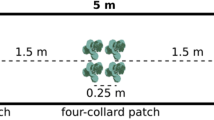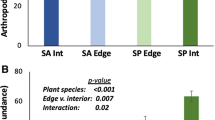Abstract
Past studies with spatially structured herbivore populations have emphasized the primacy of intrinsic factors (e.g., patch quality), patch geometry (e.g., patch size and isolation), and more recently landscape context (e.g., matrix composition) in affecting local population abundance and dispersal rate. However, few studies have examined the relative importance of each factor, or how they might interact to affect herbivore abundance or dispersal. Here, we performed a factorial field experiment to examine the independent and interactive effects of patch quality (plant biomass, leaf protein, leaf phenolics) and matrix composition [mudflat or non-host grass (Bromus inermis)] on planthopper (Prokelisia crocea) emigration from host-plant patches (prairie cordgrass, Spartina pectinata). In addition, a field survey was conducted to examine the relative importance of patch quality, geography, and matrix composition on planthopper occupancy and density. In the experiment, we found that rates of emigration from low and intermediate quality patches were, on average, 21% percent higher for patches embedded in brome than mudflat. In contrast, the emigration rate was unaffected by matrix composition in nutrient-rich patches. Within matrix types, plant quality had little effect on emigration. In the survey, planthopper density and the patch occupancy rate of planthoppers increased nonadditively with increasing patch size and the percentage of the surrounding matrix composed of mudflat. This study suggests that landscape-level factors, such as the matrix, may be more important than factors intrinsic to the patches.



Similar content being viewed by others
References
Bonte D, Lens L, Maelfait JP, Hoffmann M, Kuijken E (2003) Patch quality and connectivity influence spatial dynamics in a dune wolfspider. Oecologia 135:227–233
Brommer JE, Fred MS (1999) Movement of the Apollo butterfly Parnassius apollo related to host plant and nectar plant patches. Ecol Entomol 24:125–131
Buchsbaum RI, Valiela I, Swain T (1984) The role of phenolic compounds and other plant constituents in feeding by Canada geese in a coastal marsh. Oecologia 63:343–349
Burnham KP, Anderson DR (2002) Model selection and multimodel inference: a practical information–theoretic approach. Springer, Berlin Heidelberg New York
Cassidy TM, Fownes JH, Harrington RA (2004) Nitrogen limits an invasive perennial shrub in forest understory. Biol Invasions 6:113–121
Caudill CC (2003) Empirical evidence for nonselective recruitment and a source–sink dynamic in a mayfly metapopulation. Ecology 84:2119–2132
Cook AG, Denno RF (1994) Planthopper/plant interactions: feeding behavior, plant nutrition, plant defense, and host plant specialization. In: Denno RF, Perfect TJ (eds) Planthoppers: their ecology and management. Chapman and Hall, New York, pp 114–139
Cronin JT (2003a) Matrix heterogeneity and host–parasitoid interactions in space. Ecology 84:1506–1516
Cronin JT (2003b) Movement and spatial population structure of a prairie planthopper. Ecology 84:1179–1188
Cronin JT (2003c) Patch structure, oviposition behavior, and the distribution of parasitism risk. Ecol Monogr 73:283–300
Cronin JT (2004) Host–parasitoid extinction and colonization in a fragmented prairie landscape. Oecologia 139:503–514
Cronin JT, Haynes KJ (2004) An invasive plant promotes unstable host–parasitoid patch dynamics. Ecology 85:2772–2782
Cronin JT, Reeve J (2005) Host-parasitoid spatial ecology: a plea for a landscape-level synthesis. Proc R Soc Ser B 272:2225–2235
Cronin JT, Strong DR (1990) Density-dependent parasitism among host patches by Anagrus delicatus (Hymenoptera, Mymaridae)—experimental manipulation of hosts. J Anim Ecol 59:1019–1026
Cronin JT, Haynes KJ, Dillemuth F (2004) Spider effects on planthopper mortality, dispersal, and spatial population dynamics. Ecology 85:2134–2143
Davelos AL, Alexander HM, Slade NA (1996) Ecological genetic interactions between a clonal host plant (Spartina pectinata) and associated rust fungi (Puccina seymouriana and Puccina sparganiodes). Oecologia 105:205–213
Day RW, Quinn GP (1989) Comparisons of treatments after an analysis of variance in ecology. Ecol Monogr 59:433–463
Debinski DM, Holt RD (2000) A survey and overview of habitat fragmentation experiments. Conserv Biol 14:342–355
Denno RF, Peterson MA, Gratton C, Langelloto GA, Huberty AF, Finke DL (2000) Feeding-induced changes in plant quality mediate interspecific competition between sap-feeding herbivores. Ecology 81:1814–1827
Doak P (2000) Population consequences of restricted dispersal for an insect herbivore in subdivided habitat. Ecology 81:1828–1841
Ellis RJ (1977) Protein synthesis by isolated chloroplasts. Biochim Biophys Acta 463:185–216
Fleishman E, Ray C, Sjogren-Gulve P, Boggs CL, Murphy DD (2002) Assessing the roles of patch quality, area, and isolation in predicting metapopulation dynamics. Conserv Biol 16:706–716
Gilbert LE, Singer MC (1973) Dispersal and gene flow in a butterfly species. Am Nat 107:58–72
Gratton C, Denno RF (2003) Seasonal shift from bottom-up to top-down impact in phytophagous insect populations. Oecologia 134:487–495
Hanski I (1994) A practical model of metapopulation dynamics. J Anim Ecol 63:151–162
Hanski I (1999) Metapopulation ecology. Oxford University Press, New York
Hanski I, Kuussaari M (1995) Butterfly metapopulation dynamics. In: Cappuccino N, Price PW (eds) Population dynamics. Academic, San Diego, CA, pp 149–171
Haynes KJ, Cronin JT (2003) Matrix composition affects the spatial ecology of a prairie planthopper. Ecology 84:2856–2866
Haynes KJ, Cronin JT (2004) Confounding of patch quality and matrix effects in herbivore movement studies. Lands Ecol 19:119–124
Haynes KJ, Cronin JT (2006) Interpatch movement and edge effects: the role of behavioral responses to the landscape matrix. Oikos 113:43–54
Hill JK, Thomas CD, Lewis OT (1996) Effects of habitat patch size and isolation on dispersal by Hesperia comma butterflies: implications for metapopulation structure. J Anim Ecol 65:725–735
Hitchcock AS (1963) Manual of the grasses of the United States. Dover Publications, New York
Holder MW, Wilson SW (1992) Life history and descriptions of the immature stages of the planthopper Prokelisia crocea (Van Duzee) (Homoptera: Delphacidae). J NY Entomol Soc 100:491–497
Jones CG, Hare D, Compton SJ (1989) Measuring plant protein with the Bradford assay. J Chem Ecol 15:979–992
Kuussaari M, Nieminen M, Hanski I (1996) An experimental study of migration in the Glanville fritillary butterfly Melitaea cinxia. J Anim Ecol 65:791–801
Lawrence WS, Bach CE (1989) Chrysomelid beetle movements in relation to host-plant size and surrounding non-host vegetation. Ecology 70:1679–1690
Lurz PWW, Garson PJ, Wauters LA (1997) Effects of temporal and spatial variation in habitat quality on red squirrel dispersal behaviour. Anim Behav 54:427–435
Matter SF, Roland J (2002) An experimental examination of the effects of habitat quality on the dispersal and local abundance of the butterfly Parnassius smintheus. Ecol Entomol 27:308–316
McCullagh P, Nelder JA (1989) Generalized linear models. Chapman and Hall, London
Mobberly D (1956) Taxonomy and distribution of the genus Spartina. Iowa State Coll J Sci 30:471–574
Moilanen A, Hanski I (1998) Metapopulation dynamics: effects of habitat quality and landscape structure. Ecology 79:2503–2515
Newell SY, Porter D (2000) Microbial secondary production from salt marsh-grass shoots, and its known and potential fates. In: Weinstein MP, Kreeger DA (eds) Concepts and controversies in tidal marsh ecology. Kluwer, Dordrecht, pp 159–186
Noss RF (1991) Landscape connectivity: different functions at different scales. In: Hudson WE (eds) Landscape linkages and biodiversity. Island Press, Washington, DC, pp 27–39
Olmstead KL, Denno RF, Morton TC, Romeo JT (1997) Influence of Prokelisia planthoppers on amino acid composition and growth of Spartina alterniflora. J Chem Ecol 23:303–321
Pulliam HR, Danielson BJ (1991) Sources, sinks, and habitat selection: a landscape perspective on population dynamics. Am Nat 137:S50–S66
Quinn GP, Keough MJ (2002) Experimental design and data analysis for biologists. Cambridge University Press, Cambridge
Ricketts TH (2001) The matrix matters: effective isolation in fragmented landscapes. Am Nat 158:87–99
Ries L, Debinski DM (2001) Butterfly responses to habitat edges in the highly fragmented prairies of Central Iowa. J Anim Ecol 70:840–852
Rietsma CS, Valiela I, Buchsbaum R (1988) Detrital chemistry, growth, and food choice in the salt-marsh snail (Melampus bidentatus). Ecology 69:261–266
Roland J, Keyghobadi N, Fownes S (2000) Alpine Parnassius butterfly dispersal: effects of landscape and population size. Ecology 81:1642–1653
Schooley RL, Wiens JA (2004) Movements of cactus bugs: patch transfers, matrix resistance, and edge permeability. Landsc Ecol 19:801–810
Schtickzelle N, Baguette M (2003) Behavioral responses to habitat patch boundaries restrict dispersal and generate emigration-patch area relationships in fragmented landscapes. J Anim Ecol 72:533–545
Siska EL, Pennings SC, Buck TL, Hanisak MD (2002) Latitudinal variation in palatability of salt-marsh plants: which traits are responsible? Ecology 83:3369–3381
Stamps JA, Buechner M, Krishnan VB (1987) The effects of edge permeability and habitat geometry on emigration from patches of habitat. Am Nat 129:533–552
Summerville KS, Crist TO (2001) Effects of experimental fragmentation on patch use by butterflies and skippers (Lepidoptera). Ecology 82:1360–1370
Thomas CD, Harrison S (1992) Spatial dynamics of a patchily distributed butterfly species. J Anim Ecol 61:437–446
Thomas CD, Kunin WE (1999) The spatial structure of populations. J Anim Ecol 68:647–657
Thomas JA, Bourn NAD, Clarke RT, Stewart KE, Simcox DJ, Pearman GS, Curtis R, Goodger B (2001) The quality and isolation of habitat patches both determine where butterflies persist in fragmented landscapes. Proc R Soc Lon Ser B 268:1791–1796
Valeila IL, Koumjian L, Swain T, Teal JM, Hobbie JE (1979) Cinnamic acid inhibition of detritus feeding. Nature 280:55–57
Waterman PG, Mole S (1994) Analysis of phenolic plant metabolites. Blackwell Scientific Publications, Oxford
Wiens JA, Crawford CS, Gosz JR (1985) Boundary dynamics: a conceptual framework for studying landscape ecosystems. Oikos 45:421–427
Acknowledgments
We thank M. Stout for generously providing guidance and laboratory facilities for plant chemistry assays. K. Baum, E. Bless and C. Nelson provided assistance in the field. R. Hendrickson kindly granted access to the field site. J. Constible, T. Crist, and two anonymous reviewers gave valuable comments on earlier drafts of this manuscript. Funding was provided by Louisiana State University, a Louisiana State University Board of Regents Fellowship (K. J. Haynes), a Louisiana State University Bio-Grads Research Award (K. J Haynes), a Sigma Xi Grant-in-Aid of Research (K. J. Haynes), a Miami University Postdoctoral Research Scholarship (K. J. Haynes), and NSF grant DEB 0211359 (J. T. Cronin).
Author information
Authors and Affiliations
Corresponding author
Additional information
Communicated by Andrew Gonzales.
Rights and permissions
About this article
Cite this article
Haynes, K.J., Dillemuth, F.P., Anderson, B.J. et al. Landscape context outweighs local habitat quality in its effects on herbivore dispersal and distribution. Oecologia 151, 431–441 (2007). https://doi.org/10.1007/s00442-006-0600-3
Received:
Accepted:
Published:
Issue Date:
DOI: https://doi.org/10.1007/s00442-006-0600-3




